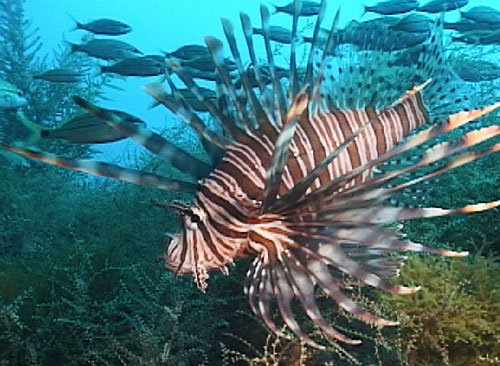NSU Newsroom
SharkBytes
Horizons
This version of NSU News has been archived as of February 28, 2019. To search through archived articles, visit nova.edu/search. To access the new version of NSU News, visit news.nova.edu.
This version of SharkBytes has been archived as of February 28, 2019. To search through archived articles, visit nova.edu/search. To access the new version of SharkBytes, visit sharkbytes.nova.edu.
Nova Southeastern University Researcher Invents Software to Predict Lionfish Invasion
An NSU researcher has invented software that helps predict invasion patterns of non-native species including the lionfish, a predatory species that has invaded Florida’s coastal waters as well as the Loxahatchee River. Matthew Johnston, M.S., a researcher at Nova’s Oceanographic Center and its National Coral Reef Institute, is the creator of InvasionSoft, a computer program that helps scientists track lionfish and other invasive species by providing models and maps of where authorities should focus their efforts to combat the invasion. Based on historical data, the computerized maps show the likely origin of the lionfish invasion and potential areas where it has spread. The software helps focus efforts to combat the nuisance fish.
“It is very accurate on a large scale and will be a useful tool to help mitigate invasions by non-native species, such as the lionfish,” said Johnston, adding that he is producing a version of the software for the Internet for the public to use freely.
Native to Northern Australia, Indian Ocean, and Indonesia, the lionfish have found their way over the years to South Florida. That’s because pet owners released them into the wild from aquariums. Their populations have mushroomed in South Florida’s tropical waters. In the Loxahatchee River, which flows from Martin and Palm Beach counties into the Atlantic Ocean, lionfish have been spotted in shallow water near mangrove trees. The lionfish is a ravenous predator and has been devouring juvenile fish. This in turn, disrupts the food chain and the ecosystem because those juvenile fish would have eventually populated coral reef ecosystems as they aged. Johnston said his software invention will be very helpful for scientists and environmental officials at the frontlines of the invasive species fight. Fisherman, he said, can also help by catching more lionfish. They are good eating fish for any dinner table.
To see InvasionSoft’s lionfish tracking data, please click on this link: http://www.kramer.mattspace.com/index.php/lionfish/lionfishanimations
